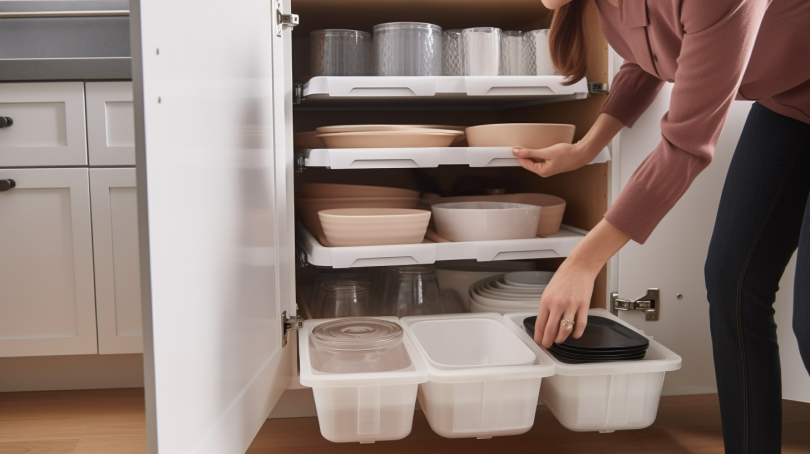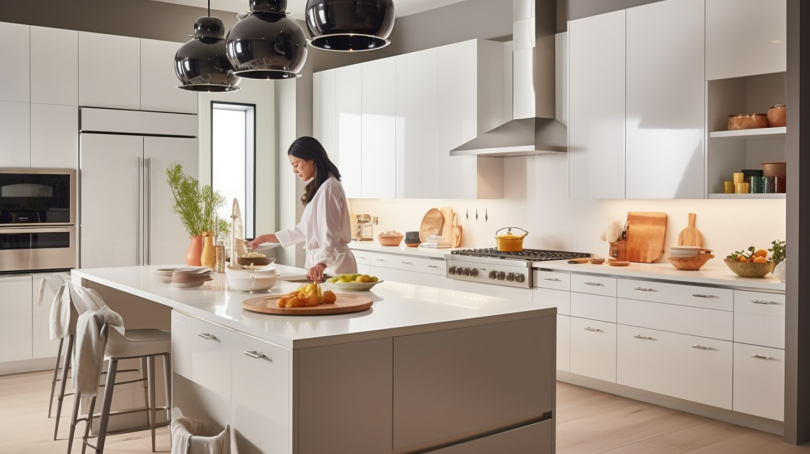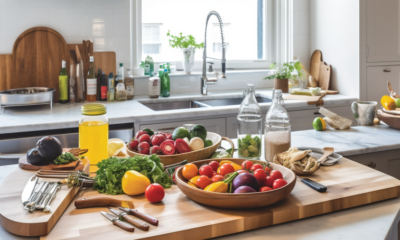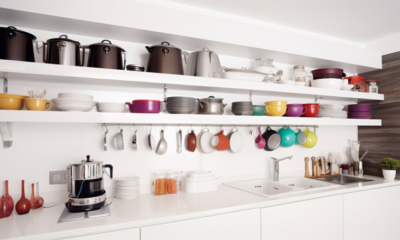Kitchen remodeling
10 Kitchen Before and After Organizational Transformations to Inspire Your Next Project
If you’re tired of a cluttered and disorganized kitchen, it’s time to consider some before and after transformations. From decluttering your countertops to maximizing your cabinet space, there are plenty of ways to make your kitchen more functional and efficient. With these simple kitchen organization tips, you can transform your space from chaos to calm. Get inspired by some amazing before and after transformations that prove that a little organization can make a big difference. Whether you need help with pantry organization or finding a better way to store your kitchen tools, there are plenty of ideas to help you get started. So why wait? Get started on your own kitchen transformation today!

Are you tired of a cluttered and disorganized kitchen? Do you struggle to find the right ingredients or utensils when you need them? You’re not alone. Kitchen organization is a common challenge for many homeowners, but the good news is that it’s easy to transform your space with a few simple changes. In this article, we’ll explore ten kitchen before-and-after organizational transformations that will inspire your next project.
1. From Cluttered Cabinets to Open Shelving
One of the most effective ways to transform your kitchen is by replacing cluttered cabinets with open shelving. This not only creates a more spacious and airy feel in the room, but it also allows you to display your favorite dishes and cookware. Consider using floating shelves for a modern touch, or go for rustic wood shelves if you prefer a more traditional look.
Case Study: Sarah from The Yellow Cape Cod transformed her dark and dated kitchen into a bright and inviting space by removing upper cabinets and installing open shelving. She used white subway tiles as a backsplash and added pops of color with accessories and plants.
2. From Messy Pantry to Organized Storage
A disorganized pantry can be frustrating and time-consuming, but with some clever storage solutions, you can turn it into a functional space that works for you. Start by decluttering items that are expired or no longer needed, then group similar items together using baskets or bins. Label everything clearly so you can find what you need at a glance.
Tips: Use clear containers for dry goods like pasta, rice, and cereal so you can see how much is left. Install wire racks on the back of the door for spices or small items.
3. From Crowded Counters to Minimalist Design
Countertop clutter can make your kitchen feel cramped and chaotic, but with a minimalist approach, you can create a clean and streamlined look. Start by removing unnecessary items and only keep the essentials on display. Consider investing in built-in appliances like a microwave or coffee maker to free up counter space.
Expert Opinion: According to interior designer Emily Henderson, “The key to a minimalist kitchen is to focus on quality over quantity. Invest in high-quality materials and appliances that will last for years.”
4. From Jumbled Drawers to Organized Dividers
Kitchen drawers can quickly become a mess if you don’t have a system in place. Use drawer dividers to separate utensils, cutlery, and other items, so they’re easy to find when you need them. You can also use dividers for pots and pans or baking sheets.
Case Study: Blogger Jenna Burger used inexpensive drawer organizers from Ikea to transform her cluttered kitchen drawers into an organized space. She grouped similar items together and labeled each section for easy access.
5. From Dull Lighting to Bright Fixtures
Good lighting is essential in any kitchen, but it’s often overlooked. Replace outdated fixtures with modern pendant lights or under-cabinet lighting for a bright and welcoming atmosphere. Consider adding dimmer switches so you can adjust the lighting according to your needs.
Tips: Choose LED bulbs for energy efficiency and longevity. Install lights above the stove or sink for task lighting.
6. From Wasted Space to Creative Storage
If you have limited space in your kitchen, it’s important to get creative with storage solutions. Use the backs of cabinet doors for spice racks or hanging storage baskets. Install pull-out shelves or drawers in lower cabinets to maximize space. Consider using a pegboard for utensils or pots and pans.
Expert Opinion: According to organizational expert Marie Kondo, “The key to effective storage is to keep things visible and accessible. Don’t hide items away in the back of a cabinet where you can’t see them.”
7. From Dated Backsplash to Bold Design
A backsplash can be a focal point in your kitchen, so don’t be afraid to make a statement with bold colors or patterns. Consider using subway tiles for a classic look, or go for mosaic tiles for a more eclectic feel. You can also use wallpaper or decals for a temporary and affordable option.
Case Study: Designer Emily Henderson transformed her outdated kitchen with a bold blue and white tile backsplash that adds personality and charm to the space.
8. From Cluttered Fridge to Streamlined Design
A cluttered fridge can be overwhelming and unappetizing, but with some simple organization tips, you can create a streamlined and functional space. Start by decluttering expired food items and grouping similar items together. Use clear bins or trays to separate fruits and vegetables, dairy products, or meats.
Tips: Use magnetic clips or hooks on the side of the fridge for grocery lists or recipes. Keep condiments in the door for easy access.
9. From Dull Cabinets to Vibrant Colors
If you’re tired of plain white cabinets, consider adding some color to your kitchen with vibrant hues like navy blue, emerald green, or sunny yellow. You can also mix and match colors for an eclectic look or use two-tone cabinets for a modern touch.
Expert Opinion: According to designer Nate Berkus, “Color is one of the easiest and most affordable ways to transform a space. Don’t be afraid to experiment with bold shades that reflect your personality.”
10. From Disorganized Junk Drawer to Functional Space
The infamous junk drawer can be a source of frustration for many homeowners, but with some clever organization, you can turn it into a functional space that works for you. Use small containers or dividers to separate items like batteries, pens, or tape. Label everything clearly so you can find what you need quickly.
Tips: Use a utensil tray for small items like paper clips or rubber bands. Keep a notepad and pen in the drawer for quick notes or reminders.
Conclusion
Kitchen organization doesn’t have to be daunting or expensive. With some simple changes and creative solutions, you can transform your space into a functional and beautiful room that reflects your personal style. Whether you’re looking to declutter your pantry, add some color to your cabinets, or install open shelving, there’s an organizational transformation that will work for you. So roll up your sleeves and get started!
Kitchen remodeling
10 Practical Tips for Effortlessly Organizing Your Tupperware.
If you’re tired of constantly sifting through a mess of mismatched Tupperware containers, it’s time to get organized. With a few simple tips, you can easily streamline your storage system and keep your food containers easy to find and use. First, clear out any items you no longer need and invest in a few versatile sizes of containers. Then, group similar items together and designate a specific area for storing Tupperware. Consider using drawer dividers or shelf risers to maximize space and keep everything tidy. Finally, don’t forget to label your containers to make them easy to identify at a glance. With these tips, you’ll be able to easily find and use the perfect container for any meal or snack.

Do you ever find yourself rummaging through your kitchen cupboard, searching for the right Tupperware lid, or struggling to fit all your containers in a limited space? If so, you’re not alone! Organizing Tupperware can be a daunting task, but with the right tips and tricks, it can be effortless. Here are ten practical tips for effortlessly organizing your Tupperware:
1. Sort by Size and Shape
The first step to organizing Tupperware is to sort it by size and shape. This way, you can easily match lids with containers and stack them neatly. Consider investing in a set of nesting containers that take up less space and are easier to organize.
Pro tip: Use drawer dividers or small bins to separate lids from containers and keep them organized.
2. Use a Storage System
A storage system can help you maximize space and keep your Tupperware organized. Consider using a pull-out drawer or shelf organizer specifically designed for storing food containers.
Pro tip: Label each container with its contents and expiration date to avoid confusion.
3. Declutter Regularly
Decluttering regularly is crucial to maintaining an organized kitchen. Go through your Tupperware collection every few months and get rid of any containers without matching lids or those that are cracked or stained beyond repair.
Pro tip: Donate any usable containers to charity organizations or repurpose them for non-food storage purposes.
4. Invest in Space-Saving Solutions
If you have limited space in your kitchen, consider investing in space-saving solutions such as collapsible containers or stackable sets that take up less room when not in use.
Pro tip: Use vertical space by installing a hanging rack or shelf for storing Tupperware lids.
5. Store Like with Like
Storing like with like means keeping similar items together. This way, you can easily find what you need without having to search through multiple containers.
Pro tip: Store all your baking supplies together, such as measuring cups and spoons, mixing bowls, and baking dishes.
6. Keep a Lid on It
Lids are often the most challenging part of organizing Tupperware. To keep them organized, store them separately from containers and use a lid organizer to keep them in place.
Pro tip: Use clear plastic bags to store lids for each container size to prevent them from getting mixed up.
7. Stack Smartly
Stacking Tupperware can save space but can also lead to chaos if done haphazardly. Stack containers of the same size and shape together, with the largest at the bottom and smallest at the top.
Pro tip: Use shelf risers or wire baskets to create additional layers for stacking Tupperware.
8. Sort by Frequency of Use
If you have limited cupboard space, consider sorting your Tupperware by frequency of use. Keep frequently used containers in an easily accessible location and less frequently used ones in harder-to-reach areas.
Pro tip: Consider using a lazy Susan or turntable for easy access to hard-to-reach items.
9. Create Zones
Create zones in your kitchen cupboard or pantry specifically dedicated to storing Tupperware. This way, you can easily find what you need without having to dig through other items.
Pro tip: Use adhesive labels or chalkboard paint to label each zone for easy identification.
10. Don’t Overdo It
Finally, don’t overdo it when it comes to Tupperware organization. Keep it simple and practical, and don’t stress over minor imperfections or mistakes.
Pro tip: Remember that the ultimate goal of organizing Tupperware is to make your life easier, not add more stress to it.
In conclusion, organizing Tupperware can be a straightforward and effortless task with the right tips and tricks. By sorting by size and shape, using a storage system, decluttering regularly, investing in space-saving solutions, storing like with like, keeping a lid on it, stacking smartly, sorting by frequency of use, creating zones, and not overdoing it, you can keep your Tupperware collection organized and your kitchen clutter-free.
Kitchen remodeling
10 Practical Tips for Efficiently Organizing Your Kitchen for Meal Prep
Organizing your kitchen for meal prep is essential for a stress-free and successful cooking experience. Start by decluttering and getting rid of any unnecessary items. Then, create designated areas for each type of ingredient, such as a pantry for dry goods and a refrigerator drawer for produce. Utilize storage containers to keep everything organized, and label them for easy identification. Consider investing in kitchen appliances, like a slow cooker or pressure cooker, to save time and simplify your meal prep process. With a well-organized kitchen, you’ll be able to whip up healthy and delicious meals in no time.

Welcome to our guide on 10 practical tips for efficiently organizing your kitchen for meal prep! Meal preparation is an excellent way to save time and money while ensuring that you eat healthy, homemade meals throughout the week. However, it can be challenging to do meal prep effectively if your kitchen is disorganized and cluttered.
The primary keyword for this topic would be “organize kitchen meal prep,” and we will cover several other keywords such as “kitchen storage, kitchen organization, meal planning, kitchen cabinets, pantry organization, kitchen shelves, refrigerator organization, kitchen counter space, kitchen utensils storage, and kitchen appliance storage.”
If you’re struggling with finding enough counter space or running out of room in your fridge or pantry, don’t worry! We have ten practical tips that will help you organize your kitchen for effective meal preparation.
1. Start With a Plan
The first step in organizing your kitchen for meal prep is to make a plan. Decide on what meals you want to prepare for the week and make a grocery list accordingly. Having a plan in place will help you save time at the grocery store and prevent food waste by only buying what you need.
2. Declutter Your Kitchen
Before you start organizing your kitchen, decluttering should be your first step. Remove any items that are expired or no longer needed. You can also donate unwanted items to charity or sell them online if they are still in good condition.
3. Optimize Your Kitchen Cabinets
Kitchen cabinets are essential for storing dry goods like pasta, rice or canned foods. To optimize this space, use clear containers or jars with labels to keep everything organized and easily accessible.
4. Organize Your Pantry
Organizing your pantry is crucial for efficient meal prep. Use shelf risers to maximize space, and group similar items together. For example, place baking ingredients, such as flour and sugar, on one shelf and canned goods on another.
5. Maximize Your Fridge Space
Maximizing your fridge space is essential for storing fresh produce, prepped meals, and condiments. Use clear containers to store fruits and vegetables and label them accordingly. You can also use a lazy Susan to store condiments or small jars of pickles or olives.
6. Utilize Your Freezer
Your freezer is an excellent tool for meal prep as it allows you to cook in bulk and freeze leftovers for later. Use freezer-safe containers or bags to store prepped meals or leftovers, and label them with the date so you can keep track of what needs to be eaten first.
7. Invest in Kitchen Shelves
Kitchen shelves are an excellent way to add storage space to your kitchen without taking up too much room. Install shelves above your sink or stove to store cookbooks, spices, or oils.
8. Create More Counter Space
If you’re struggling with limited counter space, consider investing in a kitchen island or cart that can be moved around as needed. You can also use a cutting board over your sink to create more workspace when cooking.
9. Organize Your Utensils
To keep your utensils organized, use a drawer organizer or hang them on a magnetic strip on the wall. This will not only keep everything in its place but also make it easier to find what you need when cooking.
10. Store Appliances Efficiently
When not in use, store your appliances, such as blenders or slow cookers, in a cupboard or on a shelf to keep them out of the way. You can also use an appliance garage to store frequently used appliances on your counter.
Conclusion
Organizing your kitchen for meal prep doesn’t have to be a daunting task. With these ten practical tips, you can make the most out of your kitchen space and save time and money on meal preparation. Remember to start with a plan, declutter your kitchen, and optimize your storage space using shelves, clear containers, and labels. By following these tips, you’ll be able to create an efficient and practical kitchen where you can comfortably prepare meals.
Kitchen remodeling
5 Practical Tips for Efficiently Organizing Your Cooking Utensils
Organizing your cooking utensils can make your kitchen look more tidy and efficient. One way to do this is by grouping utensils by type and size, using drawer dividers or utensil holders. Another tip is to declutter and only keep the utensils you use regularly. Hang utensils on a wall or on a magnetic rack to free up drawer space. Additionally, consider incorporating space-saving solutions like stacking bowls and nesting measuring cups to further maximize storage. By organizing your cooking utensils, you’ll have a more streamlined and functional kitchen for all your culinary adventures.

Welcome to the ultimate guide on how to efficiently organize your cooking utensils! Cooking is an art, and it requires the right tools to create delicious and savory dishes. But with so many different types of utensils available, it can be challenging to keep them organized and easily accessible. Messy drawers or cluttered countertops can make it difficult to find what you need quickly and can even discourage you from cooking altogether.
Fortunately, with a little organization and planning, you can keep your kitchen tidy and streamline your cooking process. In this tutorial, we will provide you with five practical tips for organizing your cooking utensils that will help you save time, reduce clutter, and make your kitchen more efficient.
TIP #1: Use a Utensil Holder
One of the simplest ways to organize your cooking utensils is by using a utensil holder. A utensil holder is a container that holds all of your kitchen tools in one place, making it easy to access them when needed. You can choose from a variety of materials such as ceramic, metal, or plastic depending on your preference.
If you have limited countertop space, consider using a wall-mounted utensil rack that can be installed on the wall near your stove or range. This will free up valuable counter space while keeping your utensils within reach. Alternatively, you may also use a utensil caddy that can be carried around easily from one place to another.
To maximize space inside drawers, use drawer organizers that are specifically designed for kitchen tools. These organizers come in various sizes and shapes that fit perfectly in most standard-sized drawers.
TIP #2: Group Similar Utensils Together
Grouping similar utensils together is an excellent way to keep them organized and easily accessible. For example, store all of your spatulas, whisks, and spoons in one compartment or holder. Similarly, you can keep all of your cutting boards and knives together in a designated area.
By grouping similar utensils together, you will be able to find what you need quickly and efficiently. It also makes it easier to put things away after use, reducing clutter and mess.
TIP #3: Keep Frequently Used Utensils Within Reach
It’s essential to keep frequently used utensils within reach to save time and reduce frustration. Place the utensils that you use most often near your stove or range where you can easily grab them while cooking. This includes spatulas, spoons, tongs, and any other tools that you use daily.
For less frequently used utensils like baking tools or specialty items such as a garlic press or zester, store them in a separate drawer or container away from your primary workspace. This will help declutter your cooking area while still keeping these tools within reach when needed.
TIP #4: Utilize Vertical Space
When it comes to organizing your kitchen space, don’t forget about vertical storage options. Wall-mounted racks are an excellent option for storing pots and pans, baking sheets, and other bulky items that take up too much drawer or cabinet space.
You can also use hooks to hang utensils like ladles or skimmers on the wall or under cabinets. This is a great way to keep these tools within reach while freeing up valuable drawer space.
TIP #5: Regularly Declutter Your Kitchen Utensils
Finally, it’s essential to regularly declutter your kitchen utensils to avoid accumulating unnecessary items that take up valuable space. Go through your utensil collection every few months and get rid of anything that you no longer use or need.
Consider donating items that are still in good condition to a local charity or thrift store. This will not only help declutter your kitchen but also benefit someone else who may need these items.
Conclusion
Organizing your cooking utensils doesn’t have to be a daunting task. By using the tips we’ve shared in this tutorial, you can create a functional and efficient workspace that makes cooking easier and more enjoyable. Remember to use a utensil holder, group similar utensils together, keep frequently used utensils within reach, utilize vertical space, and regularly declutter your utensil collection.
With these practical tips, you’ll be able to keep your kitchen tidy and organized while streamlining your cooking process. Happy cooking!
-
home renovation3 years ago
Step-by-Step Guide: How to Replace a Doorknob for Beginners
-
home renovation2 years ago
Setting Up a Smart Home System: A Step-by-Step Guide
-
home renovation2 years ago
How Smart Home Technology Influences Energy Consumption: A Comprehensive Analysis
-
home renovation3 years ago
Sealing Drafty Windows: A Step-by-Step Guide to Keep Your Home Comfortable and Energy-Efficient
-
home renovation2 years ago
10 Best Smart Home Gadgets and Technology for a Modern Lifestyle
-
home renovation2 years ago
The Future of Smart Home Technology: Unlocking the Potential of Home Automation
-
Home improvement financing3 years ago
Understanding Clean Energy Loans: Benefits and Eligibility Requirements
-
home renovation2 years ago
The Disadvantages of Smart Home Technology: Exploring the Drawbacks








